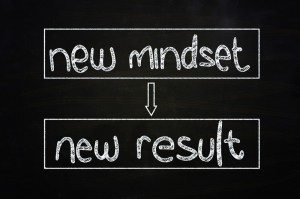The Accountable Leader: Developing the Right Mindset That Ignite Performance (Part 2)
In this second part of a 3 part article series, you will learn the last 3 critical internal factors that either strengthen or prevent you, as a leader, in developing a strong accountability mindset. Namely, your identity, motivation and attitudinal patterns and emotional state.
 Let’s first summarize what you learned in Part 1. Part 1 addressed:
Let’s first summarize what you learned in Part 1. Part 1 addressed:
- The top 3 reasons why your leaders are struggling with accountability and under-performing teams
- Why and how your “mindset” drives as much as 90% of your thoughts, feelings, behaviors, communications and, ultimately, results… in all areas of your leadership role, including accountability.
- How the first 3 mindset factors – namely, purpose/vision, values and beliefs – either strengthen or undermine your leadership capacity to drive results through healthy accountability.
To review Part 1 of t
his article series, click here.
Let’s now look at the remaining 3 mindset components of your inner leadership game for building strong accountability and a high performance organization.
Identity
Identity relates to your sense of who you are. It includes your perceptions about yourself; your strengths and self-judgments; and your roles. Your identity is mostly outside of your conscious awareness and is either your ally or foe in terms of how big of a game you play as a leader.
The language of identity is expressed through the words “I am …” The words following “I am …” provide clues how you see yourself and what you most identify with mentally and emotionally.
Empowering Identities: “I am resilient, charismatic, valuable, a change agent, etc.”Let’s take a look at specific examples how your identity shows up in your language – either verbally or in your self-talk.
- Disempowering Identities: “I am a failure, unworthy, angry, inferior, etc.”
Having worked with hundreds of leaders, I have found that to what extent your identities either empower or disempower you in your role and your capacity to drive strong accountability, has to do with your relationship with power.
To become a strong accountability leader, it is essential that you own your own personal power. You must develop an “at cause” mindset for all the outcomes in your role. You must develop a strong internal locus of control – ie., see yourself as a person who can control (or influence) your own success and destiny (rather than your outcomes being determined by outside circumstances or people).
To assess your relationship with power, ask yourself:
- When you think of the word “power,” what negative associations do you have with that word?
- Do you equate power with force? How might they be different?
- In your daily leadership role, do you find yourself on the “cause side” or “effects side” of your results equation? Ie. do you feel like you can influence the outcomes in your life or that things and circumstances happen to you (aka Victim mentality)?
A leader’s relationship with power determines to what extent a leader has the capacity to drive results through people, teams and the organization as a whole. Without a healthy, empowering relationship with power, your leadership and organizational performance will suffer and your greatest asset — your people – will be severely under-utilized.
Motivation and Attitudinal Patterns
Every individual has their own unique internal motivation and attitudinal drivers. These drivers are the invisible forces that “pull” a person forward in a specific direction.
These drivers also mirror how you are “wired inside.” That is, these patterns – uncovered through an online assessment – identify your thinking and decision making style, your primary motivators, your interest and focus filters, your relationship to time, change and even to norms and rules. These patterns predict as much as 70% of you, your team’s and your organization’s performance.
Below are 2 examples of motivation patterns that serve you as either assets or liabilities in driving strong accountability. Keep in mind that there are no “best” patterns. They each have their own strengths and pitfalls.
To keep it simple, the following tables cover only the pitfalls when an individual’s score is too high (not the pitfalls when a score is too low).
- Primary motivation drivers — Power vs Affiliation vs. Achievement
| Pattern | Strength(upside of pattern) | Pitfall (too much of pattern) |
| Power | Gets things doneTakes charge | Over control; dictatorCan offend others |
| Affiliation | TeamworkCooperation | People pleasingOverly influenced by unhappy employees |
| Achievement | Success orientedChallenges self/others to greater performance | Over-drive at all costsOften ignores needs for employee buy-in |
- Relationship to Norms/Rules – Assertive vs. Tolerant
| Pattern | Strength(upside of pattern) | Pitfall (too much of pattern) |
| Assertive | Willing to tell others expectations & rulesLives by “golden rule” | Too bossyOver-rigid with rules when flexibility needed |
| Tolerance | Let’s others do things their own wayHonors unique qualities of others | Too much autonomyDifficulty holding same rules for everyone. |
When uncovering these patterns, the overall goal is to help a leader eliminate or minimize the liability patterns while creating more flexibility in thinking and behavior for optimum leadership results.
Any patterns that are too high or too low will undermine a leader’s ability to drive best results through people.
For more information about attitude and motivation patterns and their impact on leadership and organizational performance, go to:
www.empoweredbusiness.com/solutions/organizational-performance.
Emotions
Our emotions are powerful, often unconscious, triggers that drive our behaviors, communications and state. To what extent emotions in your workplace either fuel your organization or destroy the spirit and cohesiveness of your company depends on how you handle and master your emotions in your role. First, a few basic principles about emotions important to increase your overall effectiveness as an accountable leader.
Every emotion – no matter how positive or negative — is a powerful teacher, catalyst and mirror about yourself that, when used for change and learning purposes, can ignite your leadership growth at lightening speed.
Denial or avoidance of your emotions does more harm to you as a leader than the actual emotions themselves. The truth is denying and/or avoiding your emotions – like fear or anger – only amplifies the emotion, keeps you stuck in habitual reactiveness, shuts down your rational thinking and destroys your ability to influence and lead your employees.
The “golden ratio” in emotions can unleash leadership capabilities beyond what you can imagine.
New findings show that you perform at your peak when you experience the “golden ratio” in emotions – ie., a 3 to 1 ratio of positive vs negative emotions. Not only is it unrealistic to try and be in a positive state all the time, it is detrimental to your leadership growth to not gain valuable lessons from negative emotions.
Let’s look at 2 negative emotions that often get triggered in the accountability process and what those emotions are trying to teach you.
Anger or frustration:
If either emotion gets triggered for you in the accountability process, ask yourself as a leader:
- Are you caught up in a blame mentality and not taking responsibility for your contribution to the breakdown?
- Are you a perfectionist and allow no room for employee mistakes or learning?
- Are you impatient or unrealistic in what an employee can achieve by a certain timeframe or given certain circumstances?
Anxiety or fear:
If you experience anxiety or fear in the accountability process, how might either emotion mirror the following about yourself?
- Do you suffer from negative self-perceptions or lack self-esteem?
- Do you lack key accountability skills, such as effective delegation, follow-up and coaching skills?
- When holding others accountable, do you fear conflict? Does that fear drive you to take on the tasks yourself?
- Do you fear not being liked by your employees?
In part 1 and 2 of this article series, we covered the 6 mindset drivers – mission/vision, values, beliefs, identity, motivation drivers and emotions – that account for as much as 90% of your performance and results, including accountability
The ultimate goal in these 2 articles has been to increase your awareness how mindset factors are impacting your leadership effectiveness and your capacity to drive results through your organization.
Stay tuned for part 3 of this article series to learn my top 10 leadership and culture practices for a strong accountability organization. An article you don’t want to miss!
If you would like more details about your inner leadership game, I invite you to download a complimentary report: Wired to Win Big; 7 Inner Game Leadership Strategies for Rising to the Top and Staying There.
Denise Corcoran – CEO, The Empowered BusinessTM – helps growth-seeking companies develop game-changing leadership teams and organizations that drive and sustain profitable growth by design. Denise can be reached at denise@empoweredbusiness.com or www.empoweredbusiness.com.




